|
Ron Wyatt's Discovery of Sodom & Gomorrah
Featured on
PAX Television Oct. 19, 2001
Encounters with the Unexplained
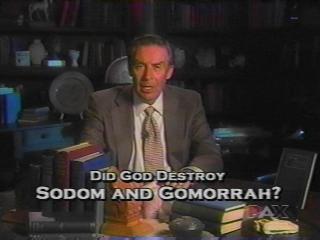
Orbach: One of the major archaeological mysteries that still perplexes
scientists and biblical scientists alike, is the location of the five cities of
the plain named in the Bible as Sodom, Gomorrah, Admah, Zeboim and Zoar. There
whereabouts are probably of little or no concern outside of archaeological
curiosity, except for one thing, the way in which these cities were said to have
been destroyed. According to the Bible God rained down fire and brimstone
on Sodom and Gomorrah, and destroyed them utterly. Over the the centuries
skeptics have questioned not only where these cities may have been, but did they
exist at all...
The argument has been going on for generations and up to now it
has never seemed to get resolved, but recent discoveries have changed the
nature of the discussion. Sources other than the Bible are now being
consulted, and the points of contention are becoming more focused on where the
cities were, and less and less on whether or not they actually existed.
But one question always remains: Did the cataclysmic event that destroyed
Sodom and Gomorrah actually happen as recorded in the Bible? Or was it a
tale invented by some early scribe to teach a frightening moral and religious
lesson?
Among the sins of the Sodomites, Ezekiel lists pride, fullness
of bread, abundance of idleness, haughtiness, and being unwilling to strengthen
the hand of the poor and needy. How did these city dwellers get so
wealthy?

Thurston: Slime pits may be the answer. Bitumen was used all over the
ancient world and was a very valuable commodity. It was used as a coating
for the burnt mud bricks, as well as the mortar, and was used to provide a
watertight caulking. Noah's ark for example was covered by pitch,
inside and out. In its various forms bitumen was in high demand in the
ancient world. In the Ebla tablets it is listed as one of the most
valuable and expensive commodities The people of Sodom and Gomorrah had it
all over the place.
Orbach: Is there any non-biblical evidence that these
cities existed, or that they were destroyed in some sort of flaming
catastrophe?
 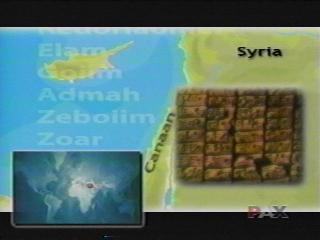
Shea: In 1978, professor Giavani Petionano of the
University of Rome, published an ancient cuneiform tablet known as the Ebla
Geographical Atlas This comes from the mid-third millennium
BC. It's a list which contains the names of 290 ancient place names.
These names come from Syria and from Canaan. Of the 290 names, several of
these bear upon Genesis 14 and the Cities of the Plain. Name number 210 is
Athma, in its old Canaanite form with a final feminine "t."
Immediately following that name is number 211 Sodom, clear to read and
phonetically equivalent with the biblical Sodom. Eight names later, comes
the name of Aqabu, the modern Aqaba, which is the gulf at the northeast end of
the Red Sea. This name of Aqaba, gives us a very important clue as to
where this Sodom is located. That puts it in southern trans-Jordan that's
where the biblical Sodom was located.
Dr. Weston Fields: Zoar is located, according to the
Medivan Mosaic Map, found a few years ago in a Byzantine church in what is now
Jordan, in the southeast area of the dead sea region.
Orbach: Much has been made of this mosaic map, and for
years archaeologists have settled on a series of small ruins near the southeast
corner of the dead sea as the likely location of all five Cities of the
Plain. But, is that location supportable in light of more recent
discoveries? Is there evidence that fire and brimstone or burning
stones actually destroyed the cities? Have other locations been found that
more closely fit the biblical and historic definitions? Is it now possible
to say that the exact sites of all five plain cities have been found?
Clues by the fist-full when we return... The location of the five cities
of the plain, as they are described in the Bible have long been the subject of
speculation and research. Archaeologists and biblical scholars have
settled on one or two spots that appear to offer some possibilities. One
of these sites is today located under the waters of the southern tip of the Dead
Sea. Another is on the Jordanian side of the Dead Sea where five archaeological
sites have been located. But there are problems. No one has been
able to get to the underwater sites to confirm whether the structures there are
natural or man made. And the five Jordanian sites are five hundred feet
above the plain that is so specifically stated in the Bible. Does the
biblical story provide any other details we could examine?
Thurston: The NIV translation of Genesis 19:24 states:

Thurston: Only Lot his wife and two daughters were spared.
Orbach: The Bible also gives us another clue of what
happened. The angel warned them not to look back If all of this is
true, shouldn't there be some residue of sulfur and ash at the authentic
sites? And what about the pillar of salt that was Lot's wife. Could
anything like that have actually happened?
We are told that Abraham looked down toward Sodom and Gomorrah,
toward all the land of the plain, and he saw dense smoke rising from the land
like smoke from a furnace. In the final analysis, the crux of the argument
over the destruction of Sodom and Gomorrah, and apparently all the land of the
plain, boils down to a single question, did it happen?
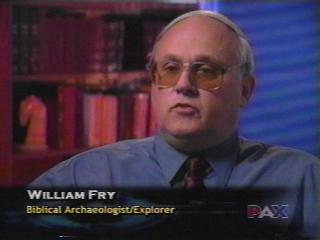
Fry: After reading the description of the destruction of
these cities from the Bible, you get a picture of what you would expect to find.
It would be a place where there is ash, sulfur, evidence of burning. It
would be a place uninhabited where nothing would grow. [William Fry was a
friend and co-worker of the late Ron Wyatt who found these lost cities of the
plain.]
Orbach: So it is possible for the cities to have been
destroyed pretty much the way the book of Genesis says they were. The
question still remaining is, has the location of those cities been
discovered?
 
Thurston: Members of the Ron Wyatt foundation found evidence in 1989,
that the five cities of the plain were not concentrated just at the end of the
Dead Sea, but rather form a line from just below the southern tip of the Dead
Sea, all the way to about ten miles or so above the northern tip.
Orbach: But, what was it Ron Wyatt had discovered that made him think
he was looking at the ruins of the five cities?
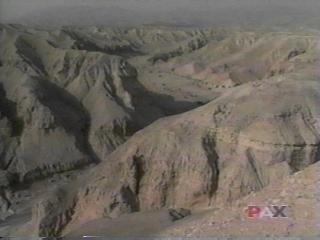 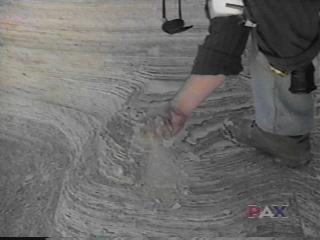
Fry: Peter tells us the cities were reduced to ash. And Josephus
points out the traces or shadows of the cities are still to be seen. These
ruins are not composed of the kind of ash we commonly think of that blows away
in the wind. It was compacted ash densely packed and crusty on the
outside, but when broken open the substance was much softer. In some
places the loose ash is amazingly deep.
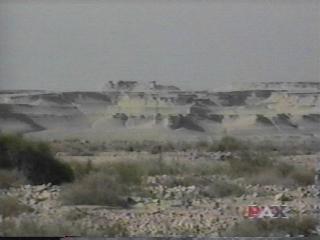 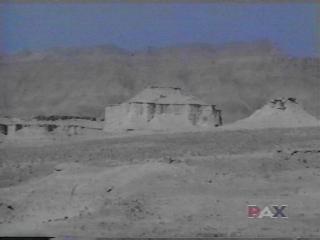
Fry: When one knows what to look for, the structure of a city becomes
obvious, walls, streets, ziggurats,
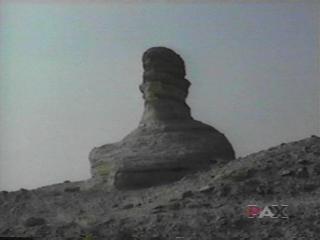 
even sphinx-like shapes are easily discernable. And the dimensions
of these ruins are more in line with what might truly be called a city.
The largest being Sodom which is in fact located near Mt. Sidom and covers more
than 140 acres.

Orbach: Even though these discoveries seem to go against the prevailing
wisdom, the locations and the archaeological and scientific evidence appears to
be quite compelling. Certainly this theory places Zoar close enough to
Sodom to give Lot and his family time enough to reach it safely. And the
depth and prevalence of the ash fits the description of the destruction.
But there is still that pesky idea of sulfur falling from the sky.
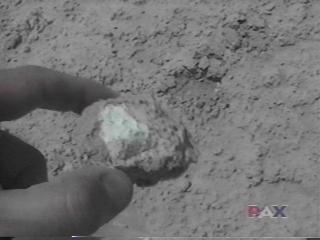 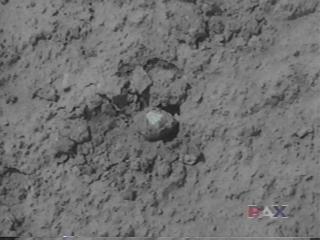
Fry: With a background in chemistry I found the balls of sulfur to be
the most exciting discovery of all. I was able to gather up several balls
of various sizes, some the size of a thumbnail, others as big as an egg.
Actually thousands of these balls of sulfur have been found and collected.
Except here in these ruins, sulfur balls like these are very rare. It's
almost as if the evidence that proves the biblical account has been miraculously
preserved along with the site itself.
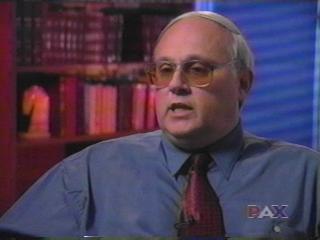
Fry: The Bible indicates the event that destroyed these cities had a
supernatural origin. We don't know the exact way it came about, but what
we do know is that these burning balls of sulfur rained down upon the cities. We
know this because the sulfur has been tested and has been shown to have been on
fire. As it rained down, all the flammable objects in the city began to
burn, and the heat from the burning sulfur began to build up over time. It
has been estimated that temperatures of up to 4000 degrees would have been
reached. This would easily create the kind of furnace-like smoke that
Abraham saw along the plain. The evidence from these sites fits not only
the biblical account of the destruction of Sodom and Gomorrah, but other
relevant scripture as well. I believe that we have indeed found abundant
evidence that these are the remains of Sodom and Gomorrah.

Orbach: Once again science and religion have an
opportunity to demonstrate they work better together than apart. Still,
one of the most fascinating aspects of these new discoveries is that they have
been there in plain site for everyone to see for ages.

End of PAX Program
|

![]()